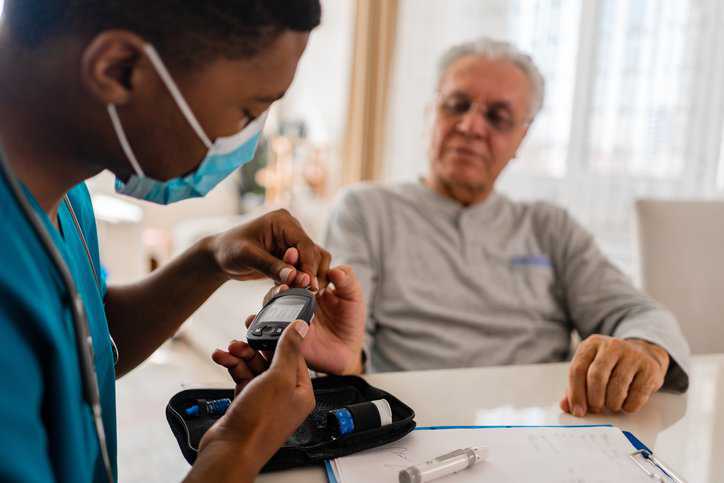ISO 15197:2013 — Blood-Glucose Monitoring Systems

In vitro means “in glass.” As such, in vitro diagnostics are tests usually conducted in test tubes and similar instruments. In vitro diagnostics (IVD) can identify a host of diseases and conditions, such as HIV, cancer, hepatitis, diabetes, or genetic disorders. IVD is therefore integral to public health because these tests allow doctors to effectively diagnose patients, provide appropriate treatments, and detect and preventing the spread of infectious diseases within communities. ISO 15197:2013 — In Vitro Diagnostic Test Systems – Requirements For Blood-Glucose Monitoring Systems For Self-Testing In Managing Diabetes Mellitus covers requirements for in vitro glucose monitoring systems measuring glucose concentrations.
What Are In Vitro Diagnostics (IVD)?
In vitro diagnostics (IVD) are tests performed—in laboratories, health care settings, or even at home—on samples taken from the human body, such as blood, urine, stool, or tissue. IVD can detect diseases, conditions, and infections, helping monitor a person’s overall health. The tests can also be utilized for in precision medicine to identify patients who are likely to benefit from specific treatments or therapies. In vitro diagnostics can even include next generation sequencing tests that scan a person’s DNA to detect genomic variations. They can provide information on complex conditions like diabetes mellitus: a metabolic disease involving inappropriately elevated blood glucose levels.
What Is ISO 15197?
ISO 15197:2013 specifies requirements for in vitro glucose monitoring systems that measure glucose concentrations in capillary blood samples. These systems are used for specific design verification procedures and for the validation of performance by the intended users. They are intended for self-measurement by lay persons for management of diabetes mellitus.
ISO 15197:2013 is applicable to manufacturers of such systems and those other organizations (e.g., regulatory authorities and conformity assessment bodies) that have the responsibility for assessing the performance of in vitro glucose monitoring systems.
What Are the Types of Diabetes?
Diabetes mellitus has several categories, including the following:
- Type 1
- Type 2
- Maturity-onset diabetes of the young (MODY)
- Gestational diabetes (diabetes while pregnant)
- Neonatal diabetes
- Secondary causes due to endocrinopathies, steroid use, etc.
The main subtypes of diabetes mellitus are Type 1 diabetes mellitus (T1DM) and Type 2 diabetes mellitus (T2DM). They classically result from defective insulin secretion (T1DM) and/or action (T2DM). T1DM presents in children or adolescents, whereas T2DM is thought to affect middle-aged and older adults who have prolonged hyperglycemia due to poor lifestyle and dietary choices. Since the pathogenesis for T1DM and T2DM is drastically different, each type of diabetes has various etiologies, presentations, and treatments.
To further your understanding of diabetes, you can check out our blog post about Diabetes Treatment and Care Standards.
How Common Is Diabetes?
Diabetes is a chronic (long-lasting) health condition that affects how your body turns food into energy. According to the CDC, 38.4 million people in the United States (11.6% of the population) have diabetes, and of those, 29.7 million have been diagnosed, and 8.7 million have not. The percentage of adults with diabetes increases with age, reaching 29.2% among those aged 65 years or older.
The most common kind of diabetes is type 2 diabetes, usually in adults, which occurs when the body becomes resistant to insulin or does not make enough insulin. Type 2 diabetes accounts for about 90% to 95% of all diagnosed cases of diabetes; type 1 diabetes accounts for about 5% to 10%.
Data Analysis: In Vitro Diagnostic in Diabetes
ISO 15197:2013 details that observations and results of the capillary blood samples obtained by the study should be documented in a report as well as the following information:
- The total number of samples analyzed
- The interval of glucose concentrations
- The glucose values measured with the device, the glucose reference values, and the packed cell volume values observed for each study participant
- A summary of the statistical analysis with confidence intervals
- A summary of any outliers excluded from statistical analysis, including the method of identification and the results of the investigation
- A scatter plot of the data
- A detailed description of the glucose reference measurement procedure, its calibration (including metrological traceability), and the validation or verification of its imprecision and bias)
- References for the statistical analysis procedures
ISO 15197:2013 — In Vitro Diagnostic Test Systems – Requirements For Blood-Glucose Monitoring Systems For Self-Testing In Managing Diabetes Mellitus is available on the ANSI Webstore.






